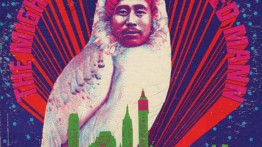Victor Moscoso A’57

Victor Moscoso A’57
Saturated color, diffuse edges, reshaped typeface, photo montage: all these are the marks of Victor Moscoso’s art. Born in Spain, he studied art at Cooper then continued his studies at Yale before moving to San Francisco, the city whose counter-culture aesthetic Moscoso greatly informed. Best known for his posters for rock concerts and work with Zap Comix, he deployed what he’d learned from the famed Bauhaus artist, Joseph Albers, who taught Moscoso at Yale. Albers may be best known for his color theory and the ways he demonstrated how juxtaposing two colors could change the depth of a painting. Moscoso put these theories to work by using bright pairs of colors in a riotous arrangement to make images that seemed to vibrate.
He applied the same techniques to his album covers, which most famously included Herbie Hancock’s hit album Headhunters (1973). Moscoso overlaid a purple filter on a photo of the band of Hancock, sitting in front of Yamaha keyboard and wearing a yellow mask Moscoso had made based on those of the Baoulé people from Ivory Coast with one significant difference: the eyes were knobs and the mouth a sound meter used in recording studios at the time.
Another Moscoso gem graced Manfred Mann’s album The Mighty Quinn (1968), whose title track was a cover of the Bob Dylan song, “Quinn the Eskimo.” The cover shows a giant birdman hovering over an electric green cityscape set in a red corona that spells out the name of the album and band. The whole composition is set on a blue, star-studded background. If Manfred Mann, which had already had a hit with the single, was worried that the ensuing album wouldn’t get as much notice, they certainly took no chances with the album’s cover art.
Moscoso, who designed covers for Jerry Garcia, The Steve Miller Band, Junior Wells and others, spoke at The Cooper Union in 2015 in a presentation called Type Confusion and Color Aggression. Noting that he was in the right place at the right time for his talents, he said, “Why did the Renaissance happen when it happened…why do these things happen? I don’t know. But when they happen, jump on them.”




